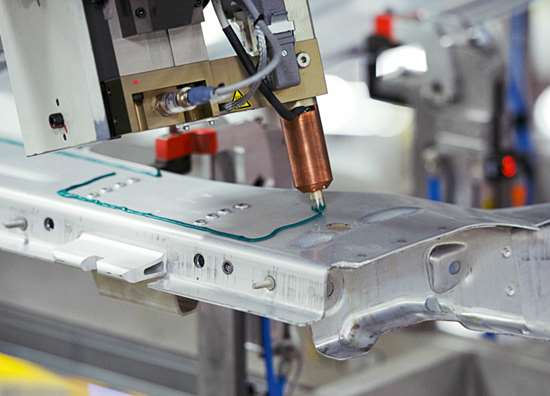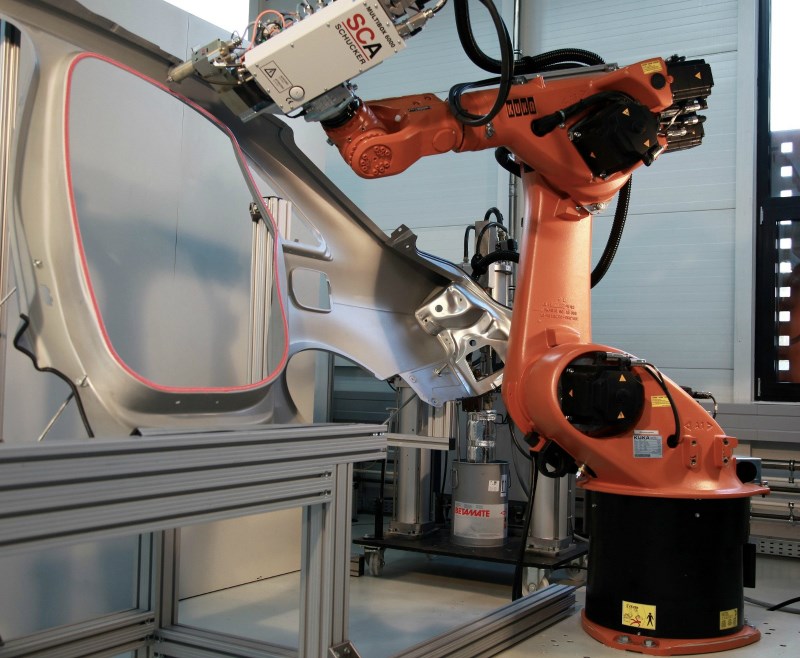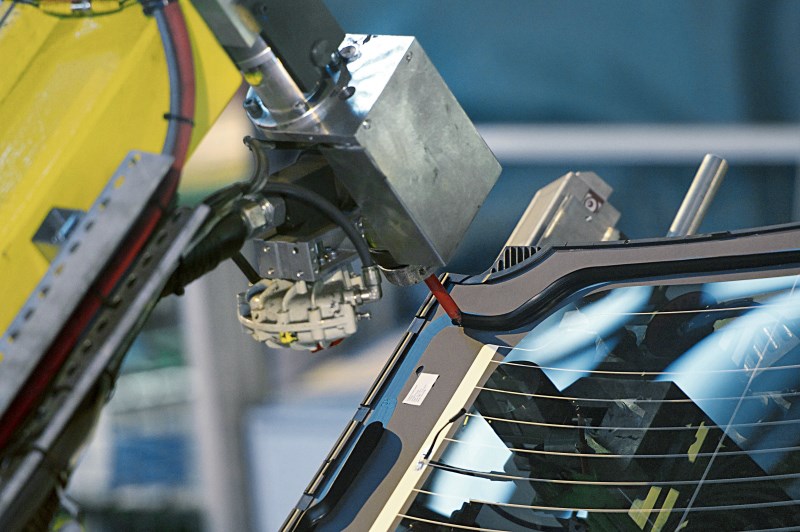Structural Adhesives Lighten the Load
Adhesives are improving unibody strength and stiffness while reducing vehicle weight.
The use of structural adhesives in assembly has been increasing; according to Leslie Wolschleger, a vice president of R&D at Sika Automotive because they can improve unibody strength and stiffness and enable vehicle weight reduction.
Light vehicle unibodies are traditionally made of steel, the components of which are commonly spot welded. In spot welding, more welds means less stress per weld. The distance between welds needs to be short enough to guarantee a level of stiffness and safety.
But no shorter: More welds also means more throughput time, material costs and weight per vehicle. Adhesives are an answer to the question of how to decrease the number of welds without sacrificing the integrity of the structure. A bead of adhesive along the weld flange takes up stress that would otherwise go into the welds—and does so well enough that fewer welds are needed. Consider a frame rail that’s spot welded. If there’s enough stress on the welds they’ll peel and the rail will split. But with a bead of the right adhesive along the entire weld line, stress is no longer concentrated only at the welds but is spread across the entire seam.
Crash-tested for Safety
This use of adhesive has obvious implications for safety, said Frank Billotto, product engineer for Dow Automotive Systems. Extreme crash-test stresses that make a welded-only rail “peel like a banana” at the weld seam will make a weld-plus-adhesive bonded rail “crumple like an accordion, but without splitting at the seam,” and absorb much more energy for better protection of car occupants, he said.
A solid bond all the way around a seam also enables more torsional rigidity in the structure, which pays off in better handling and a better driving experience.
“Drivers can feel the difference—the vehicle feels more rigid,” Wolschleger said. “They don’t know that it’s because of 80 m of adhesive on the car, but they can recognize the improved ways that the car feels when they drive it.”
Ironically, the quality of modern structural adhesive that enables that stiffness is that it has become less stiff. These adhesives are generally some formulation of epoxy—but a formulation far from what epoxy was decades ago.
“In the mid to late 1980s, epoxy was strong, but very brittle in nature. If you dropped it on the floor, it could crack,” Wolschleger noted. That made it a poor candidate for automotive unibody assembly.
“In a crash event, you don’t want your adhesive cracking in half, you want it stretching like a rubber band on a microscopic level to be able to absorb that energy,” Wolschleger said.
Over time, manufacturers have learned to formulate what they call crash-toughened or impact-modified adhesives, made with epoxies that include softer, elastic compounds of polyurethane or acrylic to enable elongation under stress.
Lightweighting Benefits
The additional strength imparted by the adhesive enables fewer welds to be required, and as the adhesive is many times lighter than those now-superfluous welds would be, it aids in meeting an OEM’s lightweighting goals. That ability to flex and expand before breaking is also what makes adhesives particularly valuable in the joining of unlike materials.
In the pursuit of lighter vehicle weight, materials such as aluminum, high-strength steel and carbon-reinforced polymers are being used in various combinations. One challenge is that a fastening method that works well with one material won’t necessarily work well with another. A method compatible with both materials needs to be used.
Another is that different materials have different thermal expansion values. “Aluminum and, say, steel have differences in the way that they expand and contract in response to temperature changes,” Wolschleger noted. “And when you start going into the composites, the differences are even more extreme. it’s even worse.”
But the right adhesive will not only create or improve the bond between materials but also be flexible enough to withstand the varying rates of thermal expansion and contraction on each side of the bond.
“Adhesives are now being relied on to bridge the gap, literally, between two types of substrate,” Wolschleger said. “We can change the elongation value of the adhesive—increase it, typically—so that we can compensate for the stresses that occur when you have different thermal expansion values of the different substrates.”
One of the concerns that have been addressed in the development of adhesives is whether they can handle the subsequent processes that bodies undergo, such as the corrosion-resisting electrophoretic coating (e-coat) process, including all of the pretreatment (e.g., degreasing, rinsing) .“There are a lot of fluids that are rushing in and out of the cavities and around the vehicle assembly before the adhesive is cured,” Billotto noted. “The adhesives have to have washout resistance.” In their uncured state, they need to have enough viscosity to stay in place while an array of liquids wash over them. “It’s a critical performance aspect.” Then it has to be able to handle the temperatures in the curing oven.
The current norm in unibody assembly is to use adhesives in addition to welds and mechanical fasteners: for all of the reasons mentioned above, the former helps to minimize the use of the latter. But as the race to reduce vehicle weight continues and the use of non-traditional materials proliferates, one might wonder if, at least in unibody construction, the mechanical fastener will become a thing of the past.
RELATED CONTENT
-
Ford Copies Nature
As Nature (yes, capital N Nature) has done a pretty good job of designing things, it is somewhat surprising that Man (ditto) doesn’t follow Nature’s lead more often when it comes to designing objects.
-
Choosing the Right Fasteners for Automotive
PennEngineering makes hundreds of different fasteners for the automotive industry with standard and custom products as well as automated assembly solutions. Discover how they’re used and how to select the right one. (Sponsored Content)
-
On Electric Pickups, Flying Taxis, and Auto Industry Transformation
Ford goes for vertical integration, DENSO and Honeywell take to the skies, how suppliers feel about their customers, how vehicle customers feel about shopping, and insights from a software exec











